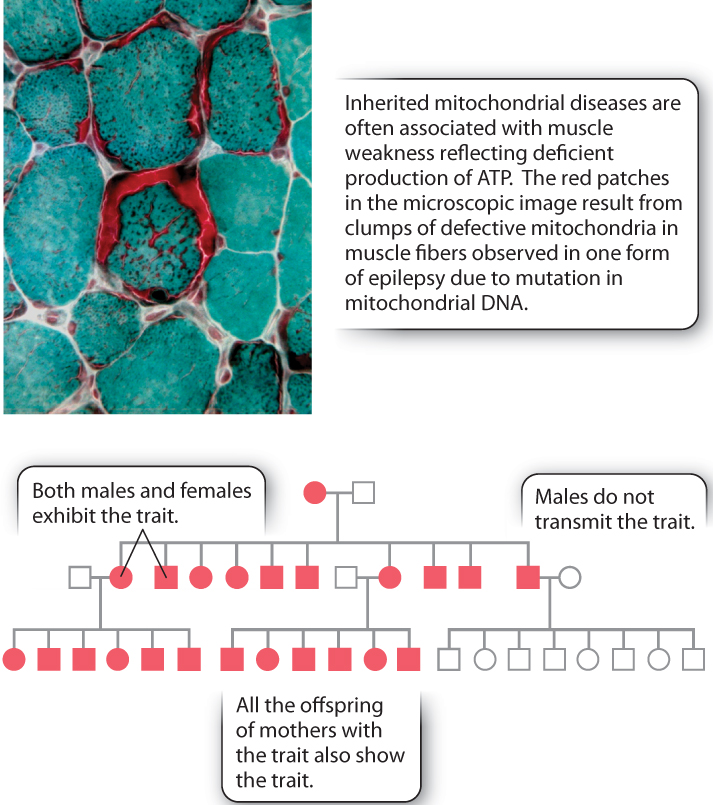17.5 INHERITANCE OF MITOCHONDRIAL AND CHLOROPLAST DNA
Sex chromosomes and linked genes are not the only genes that are inherited in ways Mendel did not describe. Genes in mitochondria and chloroplasts also show distinct inheritance patterns. Mitochondria and chloroplasts are ancient organelles of eukaryotic cells originally acquired by the engulfing of prokaryotic cells (Chapter 5). Mitochondria generate most of the ATP that cells use for their chemical energy, and they also function in the cell cycle, programmed cell death, and other important processes. Chloroplasts are found only in plant cells and eukaryotic algae. These organelles contain chlorophyll, a green pigment that absorbs light and, in the process of photosynthesis (Chapter 8), produces the sugars that are essential for growth of the plant or algal cells and of the organisms that eat them. Mitochondria and chloroplasts have their own genomes, so genes present in these genomes move with the organelle during cell division.
17.5.1 Mitochondrial and chloroplast genomes often show uniparental inheritance.
During sexual reproduction, cellular organelles do not show the regular, highly choreographed movements that chromosomes undergo during Mendelian segregation. These organelles are partitioned to the gametes along with other cytoplasmic components, and therefore their mode of inheritance depends on how the gametes are formed, how much cytoplasm is included in the gametes, and the fate of the cytoplasm in each parental gamete after fertilization.
Considering the great diversity in the details of reproduction in different groups of organisms, it is not surprising that there is a diversity of types of inheritance of cytoplasmic organelles. The three most important types are:
- Maternal inheritance, in which the organelles in the offspring cells derive from those in the mother.
- Paternal inheritance, in which the organelles in the offspring cells derive from those in the father.
- Biparental inheritance, in which the organelles in the offspring cells derive from those in both parents.
In most organisms, either maternal inheritance or paternal inheritance predominates, but sometimes there is variation from one offspring to the next. For example, transmission of the chloroplasts ranges from strictly paternal in the giant redwood Sequoia, to strictly maternal in the sunflower Helianthus, to either maternal or paternal (or less frequently biparental) in the fern Scolopendrium, to mostly maternal but sometimes paternal or biparental in the snapdragon Antirrhinum.
There is likewise great diversity among organisms in the inheritance of mitochondrial DNA. Most animals show maternal transmission of the mitochondria, as would be expected from their large, cytoplasm-rich eggs and the small, cytoplasm-poor sperm. Among other organisms, there is again much variation, including maternal transmission of mitochondria in flowering plants and paternal transmission in the green alga Chlamydomonas.
17.5.2 Maternal inheritance is characteristic of mitochondrial diseases.

In humans and other mammals, mitochondria show strictly maternal inheritance—the mitochondria in the offspring cells derive from those in the mother. Fig. 17.16 shows the characteristic pedigree patterns of a trait due to maternal inheritance:
- Both males and females can show the trait.
- All offspring from an affected female show the trait.
- Males never transmit the trait to their offspring.
The pedigree in Fig. 17.16 follows a mitochondrial disease known as MERRF syndrome (the acronym stands for “myoclonic epilepsy with ragged red fibers”). As its name suggests, the syndrome is characterized by epilepsy, a neurological disease characterized by seizures, as well as by the accumulation of abnormal mitochondria in muscle fibers. This extremely rare disease is associated with a single point mutation in a mitochondrial gene involved in protein synthesis that affects oxidative phosphorylation (Chapter 7).
More than 40 different diseases show these pedigree characteristics. They all result from mutations in the mitochondrial DNA, but the tissues and organs affected as well as the severity differs from one to the next. All of the mutations affect energy production in one way or another. In some cases, disease results directly from lack of adequate amounts of ATP, in other cases from intermediates in energy production that are toxic to the cell or that damage the mitochondrial DNA.
17-16
17.5.3 How can mitochondrial DNA be used to trace ancestry?
Case 3 You, From A to T: Your Personal Genome
Sequencing of mitochondrial DNA reveals mitochondrial haplotypes analogous to those in the Y chromosome. As in the Y chromosome, mutations in mitochondrial DNA accumulate through time, and each mitochondrial haplotype remains intact through successive generations because recombination between mitochondrial genomes is rare. This means that mitochondrial DNA can be used to trace ancestry and population history, much as described previously for the Y chromosome. The mitochondrial DNA is actually more informative than Y-chromosomal DNA because it shows substantially more genetic variation.
The use of mitochondrial DNA to trace human origins and migration is discussed in greater detail in Chapter 24. As with the Y chromosome, your personal mitochondrial genome includes information about its origin. If you want to learn about your mitochondrial DNA, you can send a tissue sample to any of a number of direct-to-consumer genotyping services that will, for a fee, analyze the DNA and provide you with a report.